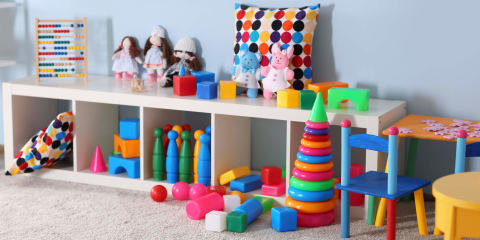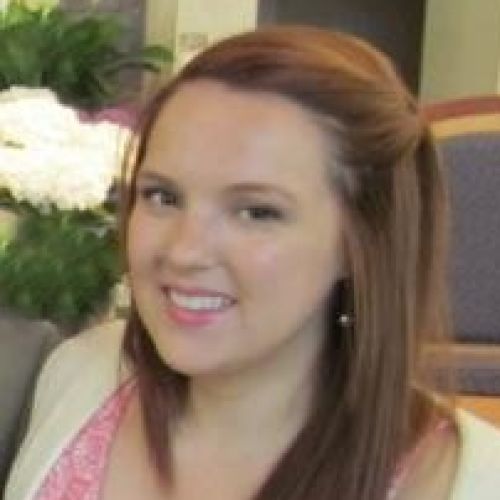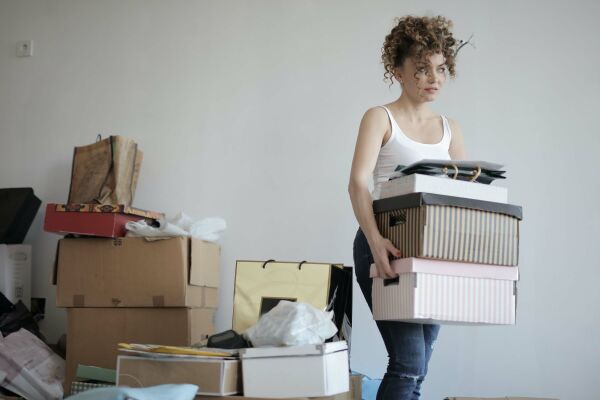Does organizing your kids’ play space fill you with as much dread as you felt when you were young and your parents asked you to clean your room?
Cleaning up after your kids—or better yet, getting them to tidy up after themselves—is an uphill battle for just about every parent. After all, it’s just going to get messy again, so why bother tidying up? The trick is to make it easy for everyone, including your kids, to put things away and find what’s needed without your help. When it’s easy for your kids to clean up after themselves, you’ll (hopefully) have less tidying of your own to do, and it’ll also be easier for them to learn to be independent and considerate of others.
Step 1: Start by decluttering
When you’re organizing any space in your home, your first step should always be to declutter. Start by tossing anything that can’t be used, like broken toys, puzzles with missing pieces, dried up markers, and headless Barbies. Items that are still usable but which your kids have grown out of can be donated to your local Goodwill or given to friends with kids of an appropriate age. If they are in good condition, kids toys are also usually very popular at garage sales.
| DECLUTTERING HACK: Try rotating your kids’ toys by storing some toys in opaque bins or in a different space in your home for a month or two. When you bust them out again, they’ll seem like a brand new toy. If your kids aren’t interested, it’s time to sell, donate, or trash that toy. |
Whether you involve your kids in the decluttering process is up to you. Older children can help you make decisions about what is kept or tossed, but some kids have a hard time letting things go. If you do decide to enlist their help:
- Work in shorter sessions to keep things from getting overly stressful
- Create a special memory box for toys and items with sentimental value. If your kids simply can’t part with a particular toy or item, even if it’s broken or unusable, it may be easier to store it in their memory box until they’re a bit older.
- Keep your “keep”, “toss”, and “donate” piles completely separate so toys you’ve agreed to get rid of don’t mysteriously creep back into the “keep” pile.
| If you notice a particular toy keeps finding its way back into the “keep” pile, you may want to consider rehoming that toy into their special memory box. You can’t always know what your kids are going to form attachments with and wish they had held on to when they get older. |
After you declutter, sort everything you plan to keep into categories, such as books, games, or craft supplies. This makes it easier to identify what storage solutions you might need to buy or repurpose from another room in your home.
Step 2: Create zones
If your kids have their own playroom, dividing the space into zones can help keep everything organized, such as:
- Art space: Painting a wall with chalkboard paint is a practical way to differentiate a craft space from the rest of your playroom. A designated craft table can also help keep clutter contained.
- Reading nook: Comfortable seating will set this space apart and encourage your kids to crack open a book. Try using picture ledges to store books so they can actually see the book covers instead of just the spine.
Rugs can also help you designate zones. Colorful puzzle piece mats are another good solution, and they are easier to clean.
Step 3: Get organized
Stop stepping on loose Lego bricks and chasing after your kids to put away their toys and craft supplies. Here are a few creative ways to keep your kids’ toys organized:
- Baskets: Hang garden baskets at a height where your kids can reach them, like the ones you see below (left) by Centsational Style (via Teepee Joy).
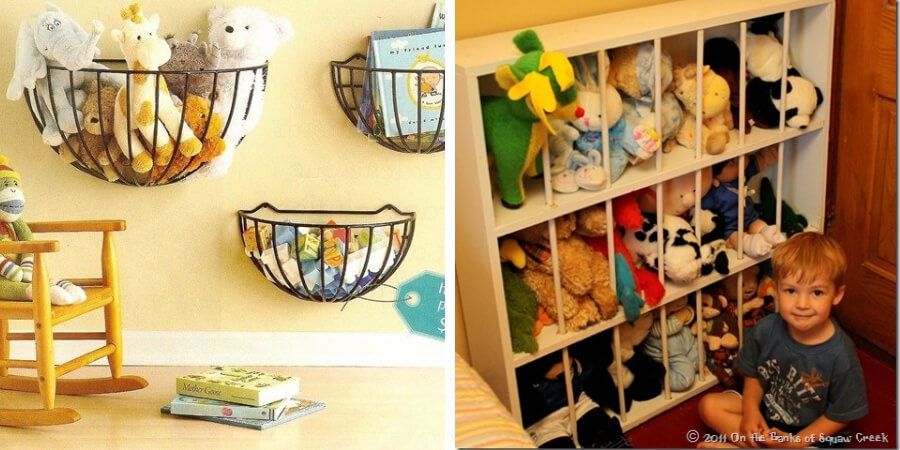
- Make them a pen: Drill holes through a bookshelf and feed bungee cords through the holes for easy access. Check it out above (right) by On The Banks of Squaw Creek (via Teepee Joy).
- Over the door: Hang a shoe organizer over your door or on your wall. Shoe organizers can also be used to store craft supplies in your art space.
- Magnetic strips: Magnetic strips mounted to your wall are a great solution for storing metal toys. Toni at Design Dazzle used this ingenious hack to store her kids’ toy cars (below left):
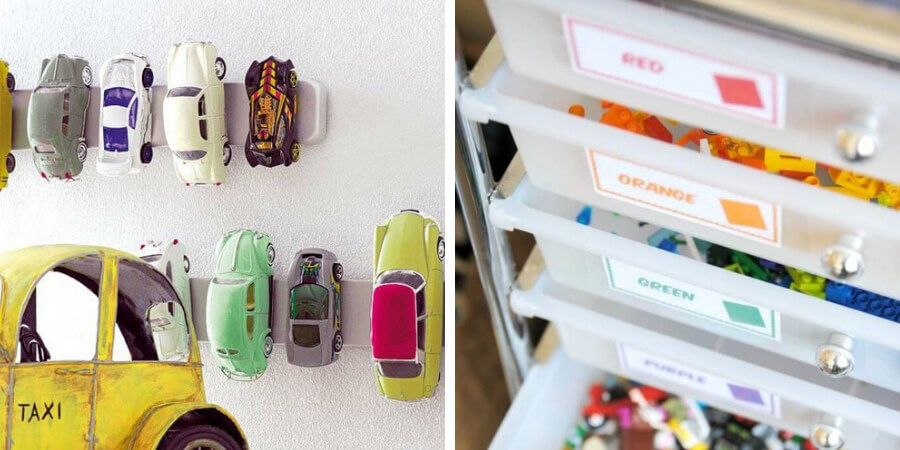
- Lego: If you have enough Lego, sort pieces into color-coded bins like Carrie at Making Lemonade (above right). Hanging metal storage bins work well too.
- Pegboard: A pegboard wall can help keep toys and supplies like diapers organized and off the floor.
- Bookshelves: Bookshelves are ideal for larger toys like puzzles and board games. You can also keep smaller toys in bins or containers, and store the bins on your bookshelf.
Step 4: Stay organized
No matter how many old toys you toss or donate or how many bins and storage benches you have, it will be difficult to stay organized if your kids can’t manage the process on their own. Here are four tips for keeping clutter under control:
1. Make it easy to find toys and put stuff away
There’s no point having a perfectly organized toy storage system if your kids can’t figure out where anything goes without your help:
- Make sure everything is easily accessible by storing frequently used toys on bottom shelves and in easy-to-open bins like these sliding bins used by @thehappinessmum:
- Use clear storage bins like @organize.my.space so it’s easy to identify what’s in each bin. For younger kids, soft bins made of light woven materials are safer and less likely to cause injury.
2. Establish a routine
Get your kids in the habit of tidying up after playtime by establishing a routine. Here are two common approaches:
- Putting away what they were playing with as soon as they break out something new.
- Big pickups, where every toy that has found its way out of its home is put away in one big sweep.
Which approach works better for your family depends on your space and your kids’ personalities. Try one, and if it doesn’t work, don’t be afraid to take a different tack.
3. Have realistic expectations
No matter how clear your system of organization is, it’s unlikely that your playroom will stay perfectly organized, especially if your kids are old enough to play without adult supervision. Don’t worry if things aren’t stored in the exact right container, or if some craft supplies have been left on the table—as long as things are put away before the clutter gets totally out of control, your playroom will be in good shape.
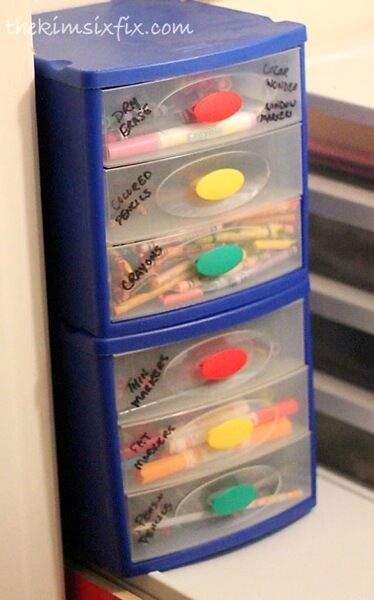 4. Don’t stress about labelling.
4. Don’t stress about labelling.
Kids’ needs change quickly, and you don’t want to have to change your labelling system every three months to accommodate their shifting tastes. Labelling each drawer or container also makes it more likely that something will be put in the “wrong” spot, and it’s likely more productive to focus on simply putting stuff away at all. After all, it’s not the end of the world if your pens and pencils get mixed together.
If you use plastic drawer units, you can temporarily label them with a permanent marker and wipe it off using rubbing alcohol if and when you change your system like Kim at the Kim Six Fix (pictured right). Just test it out on a hidden corner to make sure the marker will wipe off.
What to do if you don’t have a separate play space
If you don’t have a separate play space and your living room or another space in your home pulls double duty, don’t panic. There are a number of ways you can keep your multi-purpose spaces organized and your kids’ clutter under control:
- Furniture that doubles as storage, such as storage benches, ottomans, or coffee tables with drawer storage, will help maximize your storage options, and they’re also useful for entertaining guests. Free-standing cubbies can also be turned into stools with storage underneath.
- Cubbies and baskets are extremely effective for keeping toys and clutter organized and out of sight, but still accessible. Fabric baskets and woven bins that match your decor style will help keep you organized without compromising design. Try alphabetizing your cubby storage to maximize learning opportunities.
- Use curtains to hide cluttered shelves or storage bins. All you need is velcro!
- DIY a flip-down desk that doubles as a chalkboard and storage for craft supplies, like this kid's art desk by Ana White.
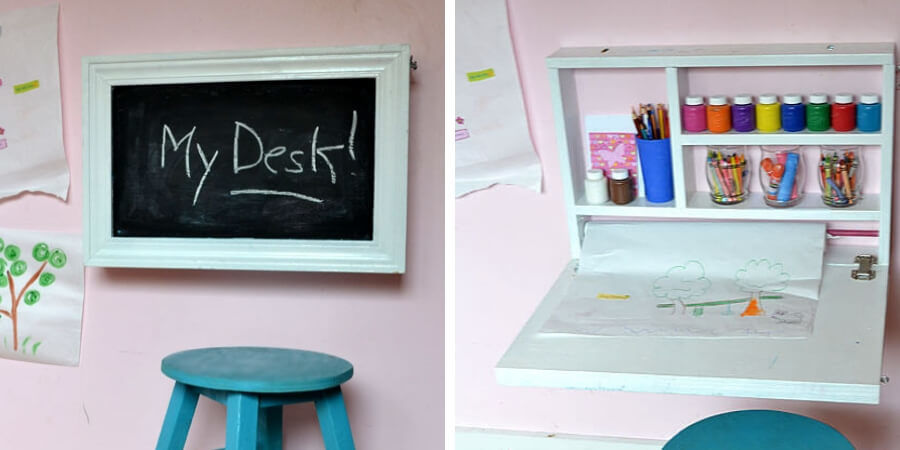
| ORGANIZATION TIP: Try not to store toys in your kids’ bedrooms. That way, they can focus on what the room is for (sleeping) without getting distracted. |
Conclusion
Organizing your kids’ playroom—and staying organized—is easy:
- Start by decluttering
- Create zones like a reading nook or art space
- Organize your kids’ toys using practical solutions like clear storage bins or creative hacks like magnetic strips
- Stay organized by making it easy to find and put away toys
Get the rest of your house in order with our other organization guides. |
